Discovering the Fascinating World of Green Mineral Stones
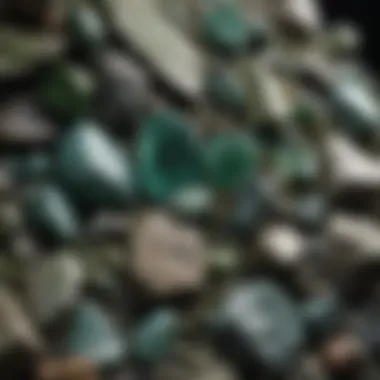
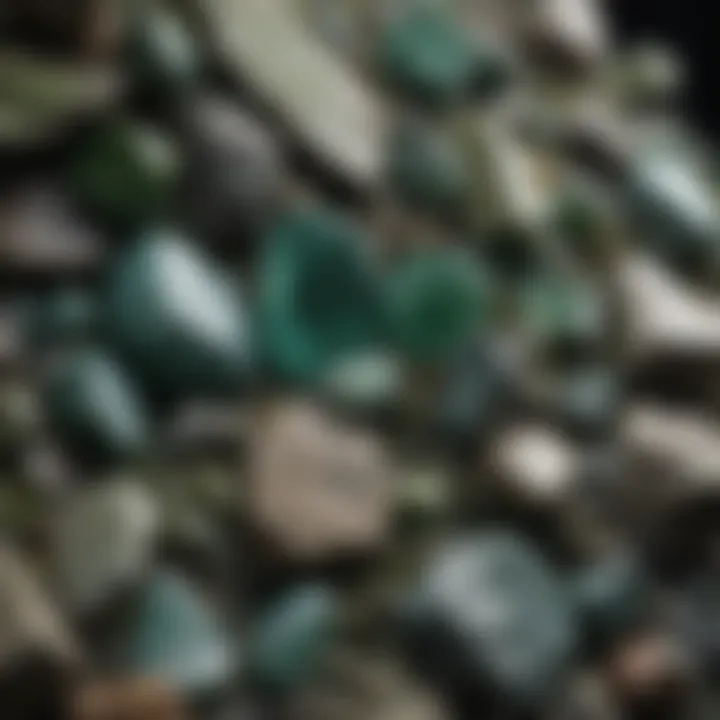
Intro
Green mineral stones have captured the imagination of many, drawing in collectors, hobbyists, and even those seeking spiritual connections. Their striking hues range from deep emerald to translucent jade, offering a palette that can evoke both tranquility and wonder. Each stone is not just a piece of rock; it carries tales from eons past, reflecting the forces of nature that shaped it into existence. Through this article, we navigate the rich terrain of green mineral stones, exploring their characteristics, cultural significance, and the ethical considerations surrounding their collection.
History and Origins
Overview of Collectibles, Rocks, and Fossils
To comprehend the allure of green mineral stones, we must first appreciate the broader context of collectibles, rocks, and fossils. These natural treasures have long been prized by humans for their beauty and rarity. The fascination dates back to ancient civilizations, where stones were often viewed as symbols of power or tools for healing. Green minerals, such as malachite and jade, have held particular significance in various cultures.
Historically, jade was revered in Chinese culture, seen as a stone of virtue and purity. In contrast, malachite was utilized by the Egyptians, not just for its striking appearance but also for its protective properties. Each stone's unique color and pattern tell a story, connecting us to ancient practices and beliefs.
Historical Significance and Cultural Impact
The historical significance of green mineral stones cannot be overstated. They have influenced art, design, and even trade. For example, jade was so valuable that it became a central trade commodity in pre-Columbian civilizations. The cultural impact is seen in many artifacts, from intricate carvings to stunning jewelry pieces, each woven with anecdotes that echo their time.
"Stones are not merely objects; they are portals to the past, linking us with the lives and beliefs of those who came before us."
As such, understanding their history enriches our appreciation of these stones today.
Identification and Classification
Guide to Identifying Rocks and Fossils
Identifying green mineral stones requires a keen eye and often a bit of practice. Beginners may feel overwhelmed, yet the process can be quite rewarding. Here are a few fundamental characteristics to consider:
- Color: This includes various shades of green, often much more nuanced than one might think. Spotted or marbled patterns can also be indicators.
- Luster: Some stones have a glassy shine, while others might appear dull or waxy.
- Hardness: Employing the Mohs hardness scale can help determine a stone's durability and classification.
- Transparency: Consider how light passes through the stone; it can range from opaque to transparent.
Common Types and Variations
Among the diverse family of green stones, several types stand out due to their unique properties and popularity.
- Malachite: Known for its striking banded patterns, it often displays stunning green shades.
- Jade: Luxurious and highly valued, jade is soft yet durable, often carved into intricate designs.
- Serpentine: This softer mineral range can show various green hues and is reputed to have protective qualities.
- Azulite: Less common, this stone is often prized for its deep forest greens.
Each of these types not only offers aesthetic pleasure but also encompasses a rich history of use and belief systems, further enhancing their allure to collectors and enthusiasts alike.
Intro to Green Mineral Stones
Green mineral stones have intrigued people for centuries, playing a significant role in both geological studies and cultural narratives. These stones, often celebrated for their striking colors and unique characteristics, form a bridge between the natural world and human history. Understanding green mineral stones not only satisfies an innate curiosity but also opens doors to deeper insights into Earth’s geological processes.
As we dive into the specifics of green mineral stones, it's essential to recognize their range of uses and significances. They’re not just beautiful items that catch the eye; these stones hold historical weight, serving various purposes in art, decor, and even medicine. Collectors are drawn to green minerals for their aesthetic appeal, while researchers and enthusiasts explore their formation and properties.
Benefits of Knowing About Green Mineral Stones
The knowledge of these stones extends beyond mere admiration. Here are some critical aspects to consider:
- Geological Insight: Learning about how these stones are formed can help us understand larger processes like plate tectonics, sedimentation, and metamorphism.
- Cultural Significance: Many green minerals have historical and cultural meanings, often associated with healing, prosperity, and protection.
- Value in Collecting: For collectors, each stone tells a story. The rarity and quality of certain types can significantly impact their market value.
- Sustainability Awareness: Understanding the ethical considerations in sourcing these stones fosters a responsible attitude towards collection and conservation.
"In studying green mineral stones, we engage in a dialogue with nature, capturing knowledge that transcends time and culture."
Taking these elements into account, the journey into the world of green mineral stones becomes an enlightening experience. From jade to malachite, each mineral carries with it a legacy that beckons further exploration. As we proceed through this article, the importance of these stones—shaped by the Earth and cherished by humanity—will become evident.
Geological Overview
Understanding the geological aspects of green mineral stones is crucial for grasping their unique characteristics. The composition, formation, and location of these stones contribute significantly to their appeal and value in the mineral market. This exploration offers insights not only to collectors but also to geologists and enthusiasts who appreciate the complexities of Earth’s processes.
Formation Processes
The formation of green mineral stones involves intricate geological processes that can span millions of years. These processes can be categorized into several stages:
- Magmatic: Some green stones, like certain types of jade, form from magma under extreme heat and pressure in the Earth’s crust. This can create stunningly beautiful stones that are coveted in jewelry and carvings.
- Metamorphic: Other stones such as emerald or serpentine arise from metamorphic processes, where existing rocks are transformed by heat, pressure, or chemically active fluids. The changes can lead to a rich variety of textures and colors during the metamorphosis.
- Sedimentary: Certain green minerals derive from sedimentary processes, where weathered rocks are eroded and deposited over time, contributing to minerals like aventurine. This process may include the accumulation of smaller particles that eventually solidify.
Understanding these processes enhances the appreciation for each stone and helps collectors identify authentic pieces.
Types of Rock Formations
Green mineral stones can be found in a variety of rock formations, which further influences their characteristics and availability. Some notable formations include:
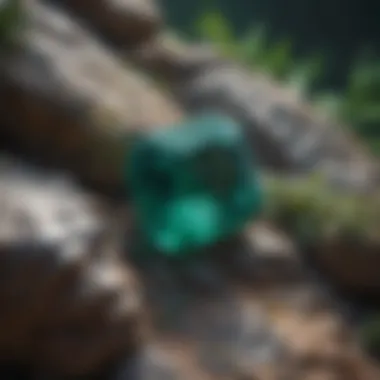
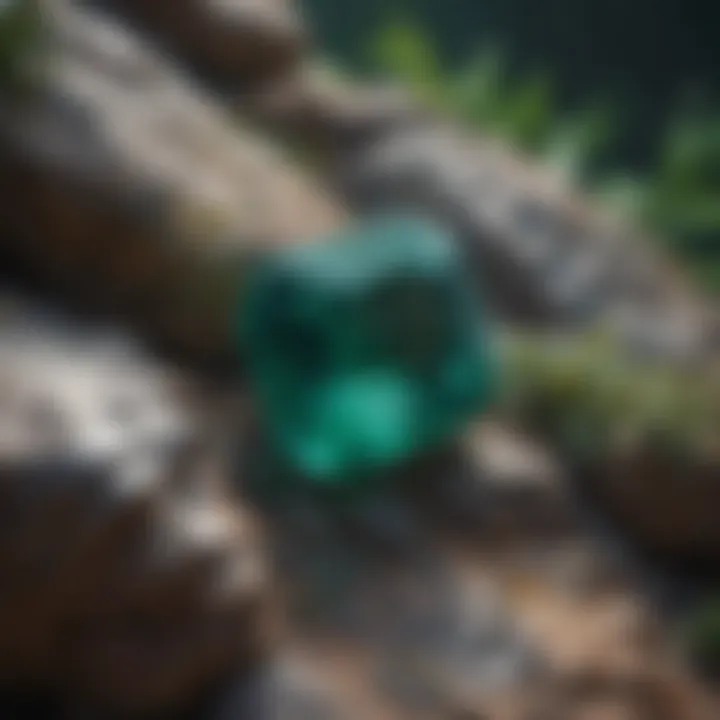
- Igneous Rocks: Formed from cooled magma, this category includes stones like some types of jade. Their crystalline structure can provide strong durability, making them desirable for various applications.
- Metamorphic Rocks: This classification includes rocks that have undergone significant transformation. Emeralds, for example, are formed in this environment, showcasing vibrant hues and often rich inclusions.
- Sedimentary Rocks: Minerals such as malachite can be found in sedimentary formations, often layered with other minerals. Their unique banding patterns and colors provide a captivating visual interest.
"Every mineral tells a story, depending on where it comes from, how it was formed, and the conditions it’s endured throughout its existence."
In summary, the geological overview of green mineral stones reveals the fascinating interplay between natural processes and the unique attributes of these stones. Knowledge of formation processes and rock types aids in understanding their origins, enhancing both the collecting experience and scientific discourse.
Types of Green Mineral Stones
Understanding the various types of green mineral stones is crucial for anyone looking to delve into the fascinating world of geology and mineralogy. Each type tells its own story through its unique formation, properties, and uses. Collectors and enthusiasts alike find joy in identifying and appreciating these differences. This section will explore five notable green mineral stones: Jade, Emerald, Malachite, Serpentine, and Aventurine. Each stone possesses distinct features that contribute not only to its aesthetic appeal but also to its economic and cultural significance.
Jade
Jade is more than just a pretty stone; it has long been revered in various cultures around the world, especially across Asia and among the indigenous people of Central America. Comprising primarily jadeite and nephrite, this gemstone varies significantly in color, ranging from deep green to almost white. Its toughness and ability to be finely carved makes it highly prized in jewelry and ornamental objects. Historically, the Chinese considered jade a symbol of purity and moral integrity. Today, jade remains highly sought after, not just for its beauty but also for its cultural connections and traditional beliefs about good fortune.
Emerald
Emeralds stand out for their vibrant green tone, a color that can make any piece of jewelry pop. The richness of an emerald’s hue is due to traces of chromium and sometimes vanadium. Although Colombia is often considered the top source, high-quality emeralds are also mined in Zambia, Brazil, and Afghanistan. In addition to their beauty, emeralds have a storied history, often associated with love, rebirth, and fertility. Collectors may find emeralds captivating due to their rarity and the stories they carry. However, it's worth noting that many emeralds undergo treatments that enhance clarity; therefore, understanding the treatment process is vital for collectors.
Malachite
Typically characterized by its intricate banding and vibrant green color, malachite draws attention for both its aesthetic charm and its history. This mineral is primarily found in copper deposits, and its striking, smooth texture makes it ideal for crafting ornamental pieces and jewelry. Malachite’s unique patterns include swirls and bands, and no two stones are alike. Though cherished for its beauty, it is also used in historical contexts for pigment—its powdered form once served as a green paint. Interestingly, malachite has also been regarded as a protective stone in various cultures, thought to absorb negative energies.
Serpentine
Serpentine is not a single stone but rather a group of minerals, with varying shades of green to yellow-green. It's commonly used in sculptures and carvings due to its soft nature, making it easy to work with. The patterns can resemble snakeskin, lending it a unique charm. Serpentine has a rich history, often associated with healing and protection, enhancing its appeal to metaphysical enthusiasts. Collectors appreciate serpentine for its distinct appearance and accessibility, as it tends to be more abundant than some other green stones.
Aventurine
Aventurine is often recognized for its shimmering effect, known as "aventurescence," caused by tiny inclusions of mica or hematite. The stone is typically a lighter green, though it can also appear in shades of blue and orange. It's thought to promote luck and prosperity, hence its popularity among those interested in metaphysical properties. In terms of economic value, aventurine is more affordable than many other stones, making it a good starting point for new collectors looking to build their inventory without breaking the bank.
A deep understanding of these green mineral stones not only enhances the appreciation of their beauty but also reveals the rich cultural and historical narratives they carry. Collectors and enthusiasts benefit from recognizing these unique attributes, which deepen their engagement with each piece they encounter.
Physical Properties and Characteristics
Understanding the physical properties and characteristics of green mineral stones is crucial for anyone interested in geology, mineralogy, or even simply collecting these natural wonders. These properties help in identifying stones, assessing their value, and determining their durability for various applications. When examining green mineral stones, one typically considers factors such as color variations, clarity and transparency, as well as hardness and durability. Each of these aspects tells a unique story about the stone's origin, usage, and its journey through time.
Color Variations
Color is undoubtedly one of the most striking characteristics of green mineral stones. Shades can range from the softest olive hue to deep forest greens, and everything in between. Some of the most recognizable examples include jadeite and nephrite in jade, as well as various emeralds that exhibit lush, vibrant colors. The color can be influenced by factors such as mineral content, the stone's crystalline structure, and even the surrounding geological environment during formation.
Usually, mineral stones are composed of different elements and can show unexpected color variations due to impurities. For example, malachite can display bands of bright green along with darker veins, creating a stunning visual effect. The deep green colors often signify a higher copper content, which is both commercially and aesthetically appealing to collectors.
Important Points About Color:
- Market Value: In many cases, the intensity and saturation of the color can significantly affect the stone’s market value.
- Trends: Color trends can change over time, influencing what collectors are actively seeking.
- Natural Beauty: The myriad hues can also enhance the aesthetic appeal of various items, making them sought after in jewelry and decorative arts.
Clarity and Transparency
Clarity refers to the presence of inclusions or blemishes within the stone, while transparency deals with how light passes through. Stones like emeralds are renowned for their captivating green translucency, yet they often possess notable inclusions, earning them the nickname "gardens."
In contrast, some collectors might look for stones with high clarity, which can reflect light brilliantly and showcase the vibrant greens even more. High levels of clarity in a green stone also contribute to its rarity, further raising its appeal. For instance, the allure of a flawless piece of jade is hard to overlook — its smooth surface reflecting light like a natural mirror.
Key Considerations About Clarity:
- Rarity: Clear stones are often rarer and can fetch higher prices.
- Aesthetic Quality: The right combination of clarity and color can elevate a stone’s beauty to artistic levels.
- Optical Properties: Some stones may display phenomena such as cat’s eye effects or pleochroism, which can further enhance their desirability.
Hardness and Durability
The hardness of mineral stones is measured on the Mohs scale, which ranges from 1 (talc) to 10 (diamond). Many green mineral stones possess varying degrees of hardness, impacting their usage and care. For example, jade rates between 6 and 7, making it relatively resilient and suitable for carving intricate designs. In contrast, emerald, although desired for its beauty, rates only about 7.5 to 8 due to its cleavage, meaning it can chip or break more easily when subjected to pressure.
This durability impacts not just collectors but artisans too, shaping the crafting techniques they employ. Stone carvers must take into account the hardness to achieve the desired shape without compromising the integrity of the gem.
Factors Influencing Durability:
- Usage: Jewelry stones require a higher degree of durability to withstand wear and tear.
- Environmental Factors: Stones can be affected by acids or harsh chemicals, which may cause degradation over time.
- Care Tips: Proper storage and handling can extend the life of the stone, ensuring that it retains both beauty and value.
"The beauty of green mineral stones lies not only in their colors but in the stories their physical characteristics tell."
To sum things up, the physical properties and characteristics of green mineral stones serve as a fundamental framework in understanding their value and individuality. Collectors who take the time to appreciate these distinctions often find themselves more enriched in their pursuits, whether exploring them in nature or curating them in their own collections.
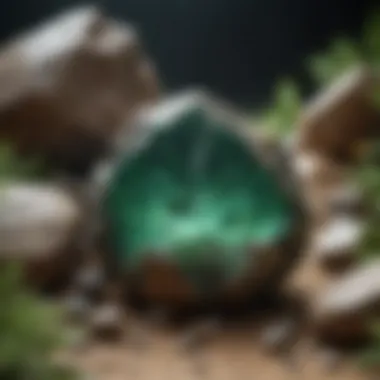
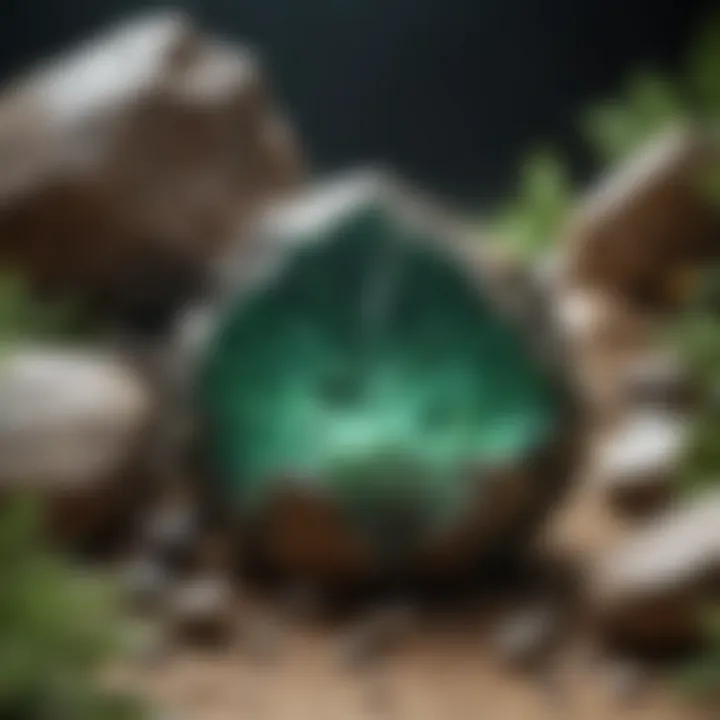
Cultural Significance
Green mineral stones are not merely geological formations; they weave a colorful tapestry rich in history and meaning across various cultures. From ancient civilizations to modern practitioners of metaphysical beliefs, the relevance of these stones is profound, often serving purposes that extend beyond mere aesthetics.
Historical Uses
Throughout the ages, green stones have held significant utility. For the ancient Chinese, jade was more than a beautiful gem; it symbolized purity and moral integrity. Used in tools, ceremonial objects, and even burial items, jade was thought to grant protection and enhance one’s honesty.
In ancient Egypt, precious stones such as emeralds were prized by pharaohs. Used to adorn jewelry, these stones were not only decorative but also believed to possess protective qualities. They were associated with the goddess Isis, embodying fertility and rebirth. Roman culture, too, revered emeralds, associating them with love and fidelity. It’s clear that green stones have traversed the sands of time, consistently finding relevance in human affairs.
- Jade: Used in tools and jewelry for protection in ancient China.
- Emerald: Adored by Egyptian royalty, linked with rebirth and protection.
- Serpentine: Utilized in ancient rituals for its perceived healing properties in various cultures.
Symbolic Meanings
The meanings attributed to green mineral stones extend beyond their physical beauty, entwining them with concepts of prosperity, renewal, and balance. Many cultures regard green as the color of life and growth. For instance, in many Indigenous cultures across North America, the color green is seen as a symbol of renewal and sustenance. It resembles the lushness of nature and the hope it brings.
Emeralds, in particular, are often connected to themes of love. They are said to encourage unity and promote harmony in relationships. The stone's vivid hue is believed to embody tenderness and affection, making it a popular choice for gifts between lovers. Similarly, malachite, known for its striking patterns, is recognized as a protective talisman, believed to ward off negative energies and promote emotional healing.
Folklore and Myths
Legends and myths surrounding green mineral stones are as varied as the stones themselves. In many cultures, these stones are thought to harbor protective spirits or significant energy.
For example, the tale of Serpentine often depicts it as a healing stone that can rejuvenate physical and emotional well-being. Many believe that carrying serpentine can deter snake bites—an interesting twist considering its name!
In Ireland, the emerald is not merely a stone; it is woven deeply into the fabric of national identity, symbolizing luck and the lush beauty of the Emerald Isle. Folklore suggests that wearing emeralds can enhance insight and foresight, making them particularly cherished among the Irish.
"Stones like emerald and jade have the power to transcend time, reminding us that nature's beauty is intertwined with the human experience."
As we explore the cultural significance of green mineral stones, we see they serve various roles—from utilitarian to symbolic. Each stone carries with it stories, meanings, and a legacy that connects us to our past and guides us in looking to the future.
Economic Value and Market Trends
The realm of green mineral stones is not just about their beauty or unique properties; there's a whole economic layer that provides insights into their value and market trends. Understanding the economic value of these stones is crucial for enthusiasts and collectors alike, as it not only informs purchase decisions but also sheds light on the rarity and desirability of specific types.
Collectible Stones
When we talk about collectible stones, we venture into a niche that brings together passionate collectors, gemologists, and investors. Green mineral stones like jade, emerald, and malachite are often sought after not just for their aesthetic appeal but also for their historical significance and rarity.
- Rarity: Many collectible green stones are rare due to their geological formation processes. Take jadeite, for instance, which is primarily found in Myanmar. Its limited availability drives up demand and, subsequently, price.
- Condition and Quality: The state of a stone plays a major role in its collectible value. Stones that are well-preserved or of exceptional quality fetch a higher price on the market. Factors like color depth, transparency, and any unique markings all contribute to the desirability and thus, economic value.
- Cultural Significance: Many of these stones boast rich histories. For collectors, owning a piece that has cultural or historical significance can be akin to owning a piece of art. For example, the symbolic meaning of jade to various Asian cultures often means it can fetch a premium when in pristine condition.
Investment Potential
Investment in green mineral stones can be a lucrative venture, given their growing market. As with any investment, understanding the underlying factors that contribute to the value is essential:
- Market Demand: The demand for green stones has seen a rise due to their increasing popularity in jewelry and decorative arts. Investors should keep an eye on trends, as fluctuating desires can affect prices.
- Economic Indicators: As is true for most collectible items, the value of green mineral stones can sometimes reflect broader economic conditions. For instance, during economic booms, luxury items, including precious stones, may see elevated prices as consumers have more disposable income.
- Diversification: For those looking to diversify their investment portfolio, green mineral stones can offer a solid addition. Unlike more traditional investments, these tangible assets often retain value over time, making them resilient to market fluctuations.
Market Accessibility
Accessing the market for green mineral stones has evolved dramatically with advances in technology and shifts in consumer behavior. Here are some key points to consider:
- Online Marketplaces: The rise of platforms such as Etsy and eBay has made it easier for collectors to buy and sell stones from the comfort of their homes. This digital access has broadened the audience, allowing boutique sellers as well as larger dealers to showcase their wares to a global audience.
- Local Gem Fairs: Attending gem and mineral fairs can offer unique opportunities for collectors. Not only can one find rare stones, but being part of the in-person event allows for networking with fellow enthusiasts and experts alike.
- Social Media and Forums: Online communities, such as specialized groups on Reddit or Facebook, are essential for keeping up with current trends, sharing insights, or even making purchases. They serve as valuable resources, providing guidance and information about authenticity and valuation.
The economic landscape surrounding green mineral stones is as variable as the stones themselves, influenced by trends, rarity, and collector interest, making it an ever-fascinating arena to navigate.
Understanding these market dynamics allows collectors to make informed decisions. Whether one is looking to invest, enhance their collection, or simply satiate their curiosity, being aware of the economic factors can greatly enhance the experience of engaging with these captivating stones.
Metaphysical Properties
The realm of metaphysical properties associated with green mineral stones draws in a vast array of enthusiasts, from collectors to spiritual practitioners. The importance of exploring this topic lies in the belief that these stones harbor unique qualities that can influence emotional and physical well-being. Particularly, green stones are associated with themes of renewal, healing, and grounding. For many, these attributes serve as a bridge to self-awareness and serenity.
Healing Attributes
Green mineral stones are often viewed as healers of the emotional and physical body. Each type of stone has its specific healing vibrations. For instance, jade is widely regarded for its abilities to promote emotional balance and harmony, soothing the mind during times of stress. Some believe that placing it on the heart area can assist in releasing blocked emotions, leading to a balanced emotional state.
- Common green stones and their healing properties:
- Jade: Enhances emotional resilience and balance.
- Malachite: Assists with transformation and change, promoting positive shifts in life.
- Aventurine: Is said to attract abundance and prosperity while encouraging optimism.
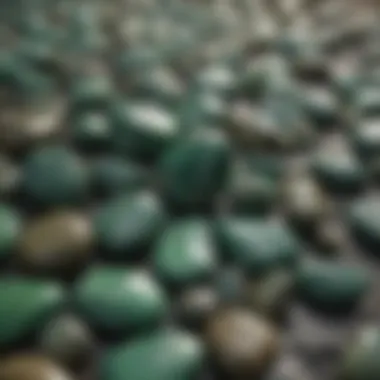

Many people report personal anecdotes that highlight the positive shifts they've experienced through the consistent use of these green stones. There's a certain je ne sais quoi about holding a piece in your hand, almost as if you are channeling the earth's energy through it, and it’s hard to deny the feel-good factor intertwined with these beliefs.
Energy Practices
The use of green mineral stones extends into various energy practices. They are thought to resonate with the heart chakra, which is intimately connected to love, compassion, and emotional stability. Practitioners often incorporate these stones into their rituals and daily routines as tools for enhancing their energetic work.
- Common energy practices with green stones:
- Meditation: Holding a green stone during meditation can help focus intentions and promote a deeper state of peace.
- Crystal Grids: Many enthusiasts use green stones in crystal grids to amplify their intentions of healing and abundance.
- Affirmations: Combining the power of affirmations while holding a green stone can enhance the practice of manifesting personal goals.
"When you align your energy with the nurturing properties of green stones, you can find a sense of balance that reverberates through your life."
Engaging with the metaphysical aspects of green mineral stones invites practitioners to create a personal connection that not only enhances their spiritual journey but also enriches their everyday existence. As you delve deeper into the practices surrounding these stones, you may find that their properties can lead you to profound personal insights and transformative experiences.
Ethical Considerations in Collecting
When it comes to the world of green mineral stones, some might forget that the beauty and allure of these specimens come with a strong moral compass. Ethical considerations in collecting are not merely suggestions; they’re essential in fostering sustainability and awareness in the broader geological community. A conscientious collector holds a responsibility to bridge the gap between their passion and the respect required for the natural world.
For instance, understanding the origins of each stone can greatly influence collection practices. Stones that are mined sustainably from ethical sources tend to hold not only more beauty but also a deeper value. Sustainable practices help maintain the ecological balance and ensure that future generations can continue to enjoy these green treasures. On the other hand, collecting stones obtained through illegal or destructive means may lead to habitat degradation and loss of biodiversity. Therefore, prioritizing ethically sourced stones is not just a trend—it’s a duty.
"Collecting should honor the earth, not exploit it."
Sustainable Practices
Sustainable practices in the collection of green mineral stones encompass various aspects, including environmental stewardship, community engagement, and personal awareness. To begin with, collectors should educate themselves on the environmental impacts of mining. Those that are actively engaged in sustainable mining operations often implement strategies to minimize land disturbance, guard against soil erosion, and protect local wildlife. By choosing stones from such sources, collectors contribute to a more responsible mining industry.
Additionally, supporting local artisans who work with locally sourced materials can play a role in sustainability. This not only reduces the carbon footprint associated with transportation but also uplifts local economies, fostering a community that thrives on eloquent craftsmanship rather than on mass-produced substitutes.
Another key aspect is the active participation in conservation projects. Join initiatives aimed at preserving habitats where these stones are found. By contributing either financially or through volunteer work, collectors can ensure that the areas which yield beautiful specimens remain protected.
Legal Aspects
Understanding the legal context surrounding the collection of green mineral stones is paramount. Every country has its own regulations regarding mineral extraction and collection. In many places, mining without appropriate permits can result in legal repercussions. This can include hefty fines and even imprisonment, which makes it crucial for collectors to do their due diligence.
On a broader scale, laws concerning the protection of natural resources are often governed by international agreements. For example, the Convention on Biological Diversity seeks to protect the ecological systems from exploitation, which extends to minerals as well. Familiarity with these agreements can add an extra layer of responsibility in your collecting practice.
Additionally, import/export laws vary from nation to nation. Understanding what stones can be legally transported across borders is essential for any international collector. A valuable piece may turn into a liability if it doesn’t meet the legal standards set by your home country’s regulations.
In sum, thoughtful collecting harmonizes passion with respect for both the environment and the rule of law. This balance enables a richer experience for the collector while ensuring the longevity and integrity of the natural resources at hand.
Caring for Green Mineral Stones
Caring for green mineral stones is crucial for maintaining their beauty and integrity, ensuring they remain valuable both aesthetically and economically. With their varied compositions and structures, these stones can be sensitive to environmental factors. Proper care not only enhances their longevity but also preserves their market value. For collectors, understanding how to care for these stunning specimens means appreciating the time and effort that goes into their formation and acquisition.
When it comes to caring for these minerals, we must consider several aspects, such as cleaning methods and storage recommendations. The right approach can prevent damage from chemicals, dust accumulation, or environmental stressors. Additionally, it’s essential to honor ethical practices in handling these natural treasures, considering their environmental and cultural significance.
Cleaning Methods
Cleaning green mineral stones requires a gentle hand and mindful techniques. Here are some effective cleaning methods:
- Soft Brushes: Use a soft-bristled brush to remove loose dirt. This is especially key for stones like jade and malachite, which can have intricate surfaces.
- Warm Water and Mild Soap: For a thorough clean, mix warm water with a little bit of mild soap. This can effectively lift grime without harsh chemicals that might damage the stone.
- Avoid Harsh Scrubs: Stay clear of abrasive materials. Scrubbing too hard can scratch or dull the stone’s surface, ruining its lively luster.
"Clean stones radiate health and vitality, capturing the attention of onlookers and collectors alike."
- Rinsing: After washing, rinse stones with fresh water to remove any soap residue. Residues can dull the appearance over time.
- Drying: Allow the stones to air dry completely. Avoid direct sunlight during the drying process, as heat can cause some minerals to crack or discolor.
Storage Recommendations
Storing green mineral stones correctly can be just as important as cleaning them. Here are some best practices for preservation:
- Separate Storage: Each mineral should be stored separately to prevent scratching and chipping. Consider using soft cloth pouches or dedicated compartments in a display case.
- Humidity Control: Store them in an area with stable humidity levels. Excess moisture can lead to mold or damage, especially for porous stones like serpentine.
- Cool, Dark Locations: Ideally, keep them in a cool, dark place away from direct sunlight. Exposure to sunlight can fade their vibrant colors over time.
- Display with Care: If showcasing your stones, use glass cabinets or display boxes to protect them from dust and accidental contact.
By taking these care and storage measures, collectors can enjoy their green mineral stones for many years to come, enhancing both their visual appeal and collectible value.
Ending
In wrapping up this exploration of green mineral stones, we recognize their significance that spans both the scientific realm and cultural fabric of society. These stones aren’t just pretty baubles—they are windows into our planet’s history, each telling a tale molded by the forces of nature over millennia. The conclusion draws attention to some pivotal elements that breathe life into the concept of these rocks; not only do they encompass physical characteristics that intrigue collectors, but they hold deeper meanings rooted in traditions and beliefs.
From jade’s association with purity in Chinese culture to emeralds revered in ancient Egypt as symbols of rebirth, such stones weave a rich tapestry of historical narratives. Collectors and enthusiasts may find that acquiring these stones transcends mere possession; it becomes a means of connecting with human heritage and geological processes which have shaped our world.
One can also ponder the vital role these stones play in today’s eco-conscious mindset. Ethical considerations about sourcing green mineral stones are becoming unavoidable discussions among collectors. As we’ve seen, sustainable collecting practices are not just noble but necessary in safeguarding these natural treasures for future generations. Understanding the implications of our choices ensures that we contribute to the preservation of both the environment and the berths of these minerals.
Inventorying one’s collection is not just an act of ownership but also an acknowledgment of the past. It’s about appreciating the value these minerals bring—not just economically, but through their stories and the ecological balance they represent.
Finally, the careful maintenance of these stones ensures their longevity and beauty, giving enthusiasts a deeper connection to their collection. Cleaning and storage practices are imperative in prolonging the life of green mineral stones, allowing for continued enjoyment and exploration.



